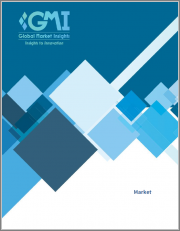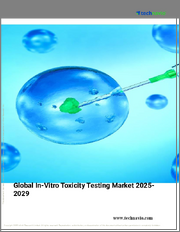
|
시장보고서
상품코드
1416176
경피 독성 테스트 시장 : 유형별, 시험법별, 시험 유형별, 최종 용도별 - 세계 예측(2023-2032년)Dermal Toxicity Testing Market - By Type (Product, Service), Testing Method (In Vivo, In Vitro, In Silico Modeling), Test Type (Skin Irritation, Sensitization, & Corrosion, Phototoxicity), End-use (Healthcare, Cosmetics)- Global Forecast 2023-2032 |
||||||
경피 독성 테스트 시장 규모는 지속 가능한 관행에 대한 관심이 높아지고 친환경 제품 시장 개척이 진행되면서 2023년부터 2032년까지 연평균 8.3%의 성장률을 보일 것으로 예상됩니다.
최근 몇 년동안 환경에 민감한 소비자와 브랜드는 유해한 화학물질이 없는 제품을 찾고 있습니다. 지속 가능한 관행에 대한 강한 관심은 성분의 품질을 보장하기 위해 경피 테스트의 채택 증가에 기여하고 있습니다.
일부 정부는 친환경 제품에 대한 철저한 경피평가를 의무화하는 규제를 강화하여 지속가능성을 촉진하고 있습니다. 또한, REACH(EU)와 FDA(미국)와 같은 세계 규제 기관은 화학물질과 화장품의 안전성과 관련하여 제품을 판매하기 전에 철저한 경피 독성 테스트를 거치도록 더욱 엄격한 규제를 제정하여 산업 확장에 박차를 가하고 있습니다.
피부 독성 시험 산업은 유형, 시험 방법, 시험 유형, 최종 용도, 지역으로 구분됩니다.
제품 유형별로는 2023년부터 2032년까지 8.4%의 연평균 복합 성장률(CAGR)로 제품 부문 시장 점유율을 크게 견인할 것으로 예상됩니다. 정교한 체외 분석 및 첨단 장비와 같은 경피 독성 테스트 제품의 지속적인 기술 혁신은 독성 평가의 상황을 변화시키는 데 도움이 되고 있습니다. 이러한 제품들은 기존 동물 실험에 대한 보다 정확하고 효율적이며 인도적인 대안을 제공하고, 윤리적 및 규제적 고려사항에 부합하는 대안이 되고 있습니다. 제약, 화장품, 화학 산업에서 첨단 경피 독성 테스트 제품의 채택이 증가함에 따라 이 분야가 더욱 확대될 것으로 예상됩니다.
최종 용도별로는 화장품 및 퍼스널케어 제품 분야의 피부 독성 테스트 시장이 2022년에 큰 수익을 창출하고 2023년부터 2032년까지 7.8%의 연평균 복합 성장률(CAGR)을 나타낼 것으로 추정됩니다. 안전하고 친환경적인 제품에 대한 소비자의 요구가 증가함에 따라 여러 브랜드가 자극, 알레르기 및 전신에 대한 유해성을 제한하는 제형을 보장하기 위해 테스트에 많은 투자를 하고 있습니다. 또한, 개인 맞춤형 뷰티 및 천연 성분과 같은 새로운 트렌드는 맞춤형 독성 평가가 필요하며, 전문 시험기관에 유리한 기회를 창출하고 있습니다.
지역별로 보면, 아시아태평양의 피부 독성 테스트 산업은 특히 중국, 인도, 한국의 화장품 및 퍼스널케어 부문의 호황으로 인해 2032년까지 8.9%의 성장률을 나타낼 것으로 예상됩니다. 이 지역의 규제 당국은 화학물질과 화장품에 대해 더욱 엄격한 안전기준을 도입하고 있으며, 이는 이 지역 시장 성장을 뒷받침하고 있습니다. 일례로 2023년 2월 가봉, 스리랑카, 자메이카는 유해한 화장품 관행에 반대하기 위해 힘을 합쳐 미백 제품에서 수은 사용을 근절하기 위해 미화 1,400만 달러 규모의 임무를 시작했습니다.
목차
제1장 조사 방법과 조사 범위
제2장 주요 요약
제3장 경피 독성 테스트 업계 인사이트
- COVID-19의 영향 분석
- 생태계 분석
- 기술 상황
- 규제 상황
- 업계에 대한 영향요인
- 성장 촉진요인
- 업계의 잠재적 리스크&과제
- 성장 가능성 분석
- Porter's Five Forces 분석
- PESTEL 분석
제4장 경쟁 구도
- 서론
- Charles River Laboratories
- Eurofins Scientific
- Qiagen N.V.
- 주요 시장 기업의 경쟁 분석
- 기업 점유율 분석
- 경쟁 포지셔닝 매트릭스
- 전략 전망 매트릭스
제5장 경피 독성 테스트 시장 규모와 예측 : 유형별, 2018년-2032년
- 주요 동향 : 유형별
- 제품
- 서비스
- 인하우스 서비스
- 아웃소싱 서비스
제6장 경피 독성 테스트 시장 규모와 예측 : 시험법별, 2018년-2032년
- 주요 동향 : 시험법 별
- 인비보 시험
- 인비트로 시험
- 인실리코 모델링
제7장 경피 독성 테스트 시장 규모와 예측 : 시험 유형별, 2018년-2032년
- 주요 동향 : 시험 유형별
- 피부 자극성 시험
- 피부 감작성 시험
- 피부 부식성 시험
- 광독성 시험
제8장 경피 독성 테스트 시장 규모와 예측 : 최종 용도별, 2018-2032년
- 주요 동향 : 최종사용자별
- 헬스케어 산업
- 화장품 및 퍼스널케어 제품 산업
- 화학 산업
- 기타 최종사용자
제9장 경피 독성 테스트 시장 규모와 예측 : 지역별, 2018-2032년
- 주요 동향 : 지역별
- 북미
- 미국
- 캐나다
- 유럽
- 독일
- 영국
- 프랑스
- 이탈리아
- 스페인
- 러시아
- 기타 유럽
- 아시아태평양
- 중국
- 일본
- 인도
- 호주
- 태국
- 말레이시아
- 필리핀
- 기타 아시아태평양
- 라틴아메리카
- 브라질
- 멕시코
- 아르헨티나
- 기타 라틴아메리카
- 중동 및 아프리카
- 사우디아라비아
- 남아프리카공화국
- 아랍에미리트(UAE)
- 기타 중동 및 아프리카
제10장 기업 개요
- QIMA LTD
- Charles River Laboratories
- Evotec
- MatTek Corporation
- Eurofins Scientific
- SGS Group
- Intertek Group
- InVivo Biosystems
- Eurofins Scientific
- Qiagen N.V.
Dermal Toxicity Testing Market size is poised to expand at 8.3% CAGR between 2023 and 2032 driven by the increasing focus on sustainable practices and the ongoing development of eco-friendly products. Of late, numerous eco-conscious consumers and brands are demanding products free of harmful chemicals. The strong focus on sustainable practices is contributing to the increasing adoption of dermal testing to ensure the quality of the ingredients.
Several governments are pushing sustainability with stricter regulations for mandating thorough dermal assessments for eco-friendly products. Moreover, regulatory bodies worldwide, such as REACH (EU) and FDA (US) are enacting stricter regulations for the safety of chemicals and cosmetics for thorough dermal toxicity testing before products can be marketed, adding to the industry expansion.
The dermal toxicity testing industry is segmented into type, testing method, test type, end-use, and region.
Based on type, the market share from the product segment is projected to gain significant traction at 8.4% CAGR from 2023-2032. The ongoing innovations in dermal toxicity testing products, such as sophisticated in vitro assays and advanced instrumentation, is helping to transform the landscape of toxicology assessment. These products offer more accurate, efficient, and humane alternatives to traditional animal testing methods to match the ethical and regulatory considerations. The increasing adoption of advanced dermal toxicity testing products by pharmaceutical, cosmetic, and chemical industries is also expected to fuel the segment expansion.
In terms of end-use, the dermal toxicity testing market from the cosmetics and personal care products segment generated substantial revenue in 2022 and is estimated to witness 7.8% CAGR between 2023 and 2032. The rising consumer demand for safe and gentle products is driving several brands to invest heavily in tests to ensure their formulations limit irritation, allergies, and systemic harm. Moreover, emerging trends like personalized beauty and natural ingredients are necessitating customized toxicity assessments, further creating lucrative opportunities for specialized testing labs.
Regionally, the Asia Pacific dermal toxicity testing industry is set to exhibit 8.9% growth rate through 2032 attributed to the presence of a booming cosmetics and personal care sector, particularly in China, India, and South Korea. Regulatory bodies across the region are implementing stricter safety standards for chemicals and cosmetics, supporting the regional market growth. To cite an instance, in February 2023, Gabon, Sri Lanka, and Jamaica joined forces to oppose harmful cosmetic practices, initiating a combined $14 million mission to eradicate the use of mercury in skin-lightening products.
Table of Contents
Chapter 1 Methodology & Scope
- 1.1 Market scope & definition
- 1.2 Base estimates & workings
- 1.3 Forecast calculations
- 1.4 Data sources
- 1.4.1 Primary
- 1.4.2 Secondary
- 1.4.2.1 Paid sources
- 1.4.2.2 Unpaid sources
Chapter 2 Executive Summary
- 2.1 Global dermal toxicity testing market 360 degree synopsis, 2018 - 2032
- 2.1.1 Regional trends
- 2.1.2 Type trends
- 2.1.3 Testing method type trends
- 2.1.4 Test type trends
- 2.1.5 End-use trends
Chapter 3 Dermal Toxicity Testing Industry Insights
- 3.1 COVID- 19 impact analysis
- 3.2 Industry ecosystem analysis
- 3.3 Technology landscape
- 3.4 Regulatory landscape
- 3.5 Industry impact forces
- 3.5.1 Growth drivers
- 3.5.1.1 Regulatory variability across the globe
- 3.5.1.2 Advancements in technology
- 3.5.1.3 Increasing awareness among consumers about product safety
- 3.5.1.4 Shifting focus on sustainable practices
- 3.5.2 Industry pitfalls & challenges
- 3.5.2.1 Lack of standardized protocols and methodologies for dermal toxicity testing
- 3.5.1 Growth drivers
- 3.6 Growth potential analysis
- 3.6.1 By type
- 3.6.2 By testing method
- 3.6.3 By test type
- 3.6.4 By end-use
- 3.7 Porter's analysis
- 3.8 PESTEL analysis
Chapter 4 Competitive Landscape, 2022
- 4.1 Introduction
- 4.1.1 Charles River Laboratories
- 4.1.2 Eurofins Scientific
- 4.1.3 Qiagen N.V.
- 4.2 Competitive analysis of major market players, 2022
- 4.3 Company market share analysis, 2022
- 4.4 Competitive positioning matrix, 2022
- 4.5 Strategic outlook matrix, 2022
Chapter 5 Dermal Toxicity Testing Market Size and Forecast, By Type, 2018-2032 (USD Million)
- 5.1 Key trends, by type
- 5.2 Product
- 5.3 Services
- 5.3.1 Inhouse services
- 5.3.2 Outsource services
Chapter 6 Dermal Toxicity Testing Market Size and Forecast, By Testing Method, 2018-2032 (USD Million)
- 6.1 Key trends, by testing method
- 6.2 In-vivo testing
- 6.3 In-vitro testing
- 6.4 In-silico modeling
Chapter 7 Dermal Toxicity Testing Market Size and Forecast, By Test Type, 2018-2032 (USD Million)
- 7.1 Key trends, by test type
- 7.2 Skin irritation tests
- 7.3 Skin sensitization tests
- 7.4 Skin corrosion tests
- 7.5 Phototoxicity tests
Chapter 8 Dermal Toxicity Testing Market Size and Forecast, By End-use, 2018-2032 (USD Million)
- 8.1 Key trends, by end-use
- 8.2 Healthcare industry
- 8.3 Cosmetics and personal care products industry
- 8.4 Chemical industry
- 8.5 Other end-users
Chapter 9 Dermal Toxicity Testing Market Size and Forecast, By Region, 2018-2032 (USD Million)
- 9.1 Key trends, by region
- 9.2 North America
- 9.2.1 U.S.
- 9.2.2 Canada
- 9.3 Europe
- 9.3.1 Germany
- 9.3.2 UK
- 9.3.3 France
- 9.3.4 Italy
- 9.3.5 Spain
- 9.3.6 Russia
- 9.3.7 Rest of Europe
- 9.4 Asia Pacific
- 9.4.1 China
- 9.4.2 Japan
- 9.4.3 India
- 9.4.4 Australia
- 9.4.5 Thailand
- 9.4.6 Malaysia
- 9.4.7 Philippines
- 9.4.8 Rest of Asia Pacific
- 9.5 Latin America
- 9.5.1 Brazil
- 9.5.2 Mexico
- 9.5.3 Argentina
- 9.5.4 Rest of Latin America
- 9.6 Middle East & Africa
- 9.6.1 Saudi Arabia
- 9.6.2 South Africa
- 9.6.3 UAE
- 9.6.4 Rest of Middle East & Africa
Chapter 10 Company Profiles
- 10.1 QIMA LTD
- 10.2 Charles River Laboratories
- 10.3 Evotec
- 10.4 MatTek Corporation
- 10.5 Eurofins Scientific
- 10.6 SGS Group
- 10.7 Intertek Group
- 10.8 InVivo Biosystems
- 10.9 Eurofins Scientific
- 10.10 Qiagen N.V.



















